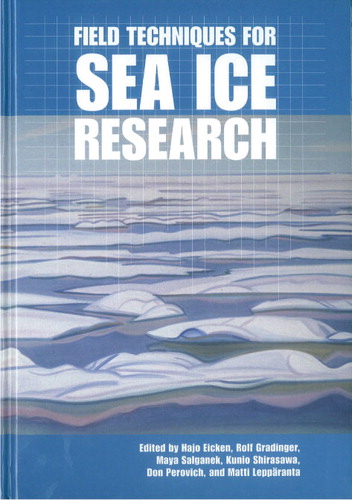Review of Field techniques for sea ice research, by Hajo Eicken, Rolf Gradinger, Maya Salganek, Kunio Shirasawa, Don Perovich & Matti Leppäranta (2009). Fairbanks: University of Alaska Press. 588 pp. ISBN 978-1602230590.
With the rapid decrease of the summer sea-ice cover in the Arctic, sea ice and the work of sea-ice researchers have been regularly in the spotlight of media and public attention in recent years. This book is a timely attempt to create a set of guidelines for the most common techniques for field measurements of sea-ice properties, filling a gap in the recently published sea-ice literature. Led by Hajo Eicken, the editors bring together 29 contributors, a group that mirrors in its composition the collaborative, international and interdisciplinary nature of sea-ice research and forms the base for the wide range of topics.
In the preface and the introductory Chapter 1, the editors set the scene for the following chapters and address some potential points for criticism such as the focus on Arctic fieldwork and the variable length and detail in the different methods section.
A vital component of the book is described in Chapter 2: the approach to research through a “Sea Ice System Services” framework. Challenging the traditional mindset of science for the sake of science, this concept encourages scientists to frame their work within social–ecological systems, taking into account how measurements of originally purely geophysical properties relate and tie into regulation, policy and decision making on local to global scales. This chapter, thus, provides a valuable demonstration of the necessity to look at sea-ice research in a broader, societal context.
The heart of the book lies in Chapter 3. The 18 sections in this chapter cover the various techniques in the different disciplines. Standard techniques such as snow observations on sea ice, ice sampling through coring, sea-ice optics and assessment of the sea-ice biota, as well as aspects such as ship-based ice observations, data management, complex setups of integrated sea-ice observation programmes and personal field logistics are introduced. While the “Sea Ice System Services” concept is incorporated in the first two sections (snow on ice and sea-ice thickness), it is largely ignored in the later sections. This is unfortunate, especially for readers new to the subject of sea-ice research because overviews such as the ones given in sections 3.1 and 3.2 provide excellent contextual material that aids in understanding the role and importance of the measurements discussed.
The sections vary widely in length and detail. Here, the book would have benefited from more editing to ensure equal treatment of the various topics. For example, the section on ice thickness measurements (admittedly, my favourite topic) is more than four times as long than the section on ice optics, in which I would have liked to have seen more detail on the methods. Nevertheless, both sections offer excellent practical advice, giving scientists new to sea-ice fieldwork an idea of the small details that determine whether you will get useful data or mostly contamination, and reminders to the more experienced not to become inattentive as new techniques become routine measurements.
The other aspect in need of more editing should there be a second edition in the future is the varying balance of practical advice versus theoretical background. At the other end of the scale to the ice optics section, the text introducing thermal, electrical and hydraulic properties of sea ice is packed with theory; the ideal would probably be somewhere in the middle.
Good data management is a challenge in every field of science and in particular in a field with such diverse datasets as found in sea-ice research. The inclusion of a section on best practices, although not a field technique in the narrow sense of the term, is, therefore, a valuable addition to the pure measurement descriptions. Sections on remote sensing and modelling of sea ice—again, not strictly speaking field techniques—are included as well. Both topics can (and do) easily fill books on their own, and here the sections can provide only a superficial overview. However, they provide good introductions, and the extensive reference lists are useful starting points for interested readers. The last section of Chapter 3 gives practical advice for personal fieldwork logistics. Although some of it may seen obvious to the experienced sea-ice researcher, the author's advice (which is probably based on personal experience) is valuable for first-timers on the ice.
The book ends with a short Chapter 4 in which the interdisciplinary nature of sea-ice research and the need for an integrated approach embedded in polar and global systems science are discussed, closing the circle to the start of the book.
A DVD with additional resources in form of videos, animations and supplementary material accompanies the book. A video about the social science perspective of sea ice and, in particular, about assessing the changes in the Arctic sea-ice cover with respect to the social–ecological system and politics nicely complements Chapter 2 and the idea of the “Sea Ice System Services” framework. The video clips providing additional information to the sections of Chapter 3 are drawn from material produced during the field course that has been the base of the entire book. Together with the field course reports and other course material, they provide background to the origins of the book and nicely visualize some of the techniques presented. The material provided for ship-based ice observations demonstrates the complexity of such a seemingly simple task.
Despite the book's shortcomings—varying depth and detail in the technique sections, strong emphasis on Arctic sea-ice research, lack of incorporation of the “Sea-Ice System Services” concept in the later sections of Chapter 3—Hajo Eicken and colleagues have produced an impressive textbook about techniques in field-based sea-ice research, which will serve both students and experienced sea-ice scientists. Such a compilation of standard measurement techniques is much needed in this young field that is fast evolving and increasingly in the spotlight of the public.
